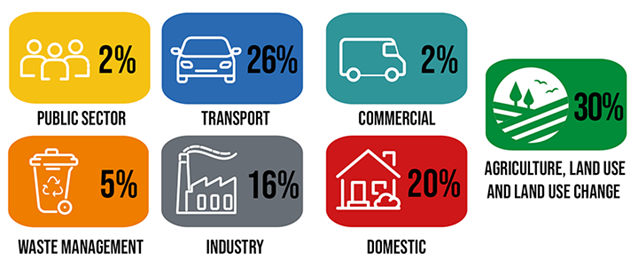The Situation in Herefordshire
Where do Herefordshire's emissions come from? 
The Local Impact
If global temperatures continue to rise, then in Herefordshire we could expect the maximum temperature of the hottest day of the year to continue to increase. The number of hot days exceeding 25c is likely to increase, meaning a higher risk of heat related illness - especially for the vulnerable population. Flooding would also become more likely, and severe. Read below for more info or see the BBC's What will climate change look like near me page.
Flooding
One of the most obvious local impacts of climate change is the increase in frequency and severity of flooding in Herefordshire.
Herefordshire Council works with the emergency services, the Environment Agency, the Met Office and the utility companies to tackle flooding within the county. Together with other partner authorities and key stakeholders in Herefordshire, the council have produced a Local Flood Risk Management Strategy.
For more information on flooding, including how to prepare for a flood, reporting floods and support after flooding please visit Herefordshire Council's after a flood page.
More Hot Days
Due to the impacts of climate change, heatwaves will become increasingly more likely, and with them the associated risks of extreme heat. The most vulnerable in the population, including the elderly, young children and babies, and pregnant mothers, will be most susceptible.
Mitigating actions are the first and most important actions we can take to reduce the risk of extreme heat. By minimising or eliminating our consumption of fossil fuels, and thinking carefully about the products we create and consume, we can work to slow the pace of climate change and its associated affects.
However, we are already seeing may of these affects, such as through the 40c heat we experienced across the county in summer 2022. Adapting to climate change will therefore play a part in protecting ourselves from the worst of the risks. We can do this by, for example, increasing tree canopy cover across our towns, cities, and neighbourhoods to increase shaded space, or through ensuring new developments take heat risks into consideration when looking at window placement, insulation, and ventilation.
Getting Involved
Everyone from across the county can get actively involved in the Greener Footprints campaign, which is driven by the community for the community to help Herefordshire to be net zero by 2030.
The aim is to encourage, inspire and mobilise people and organisations from all corners of the community to be part of a Herefordshire-wide "movement of positive action" on a scale never seen before, in order to tackle climate change and protect the county's rich nature and wildlife.
Find out how to get involved and make your pledge today.
Offsetting
Achieving net carbon zero will mean that we will have to deal with emissions that remain after all possible actions have been carried out. Some sectors such as transport will not be able to get to zero emissions and so offsetting that remaining carbon through sequestration will be necessary. Carbon sequestration is the process of capturing and storing carbon dioxide, for example by planting additional trees that absorb carbon dioxide and store the carbon.

